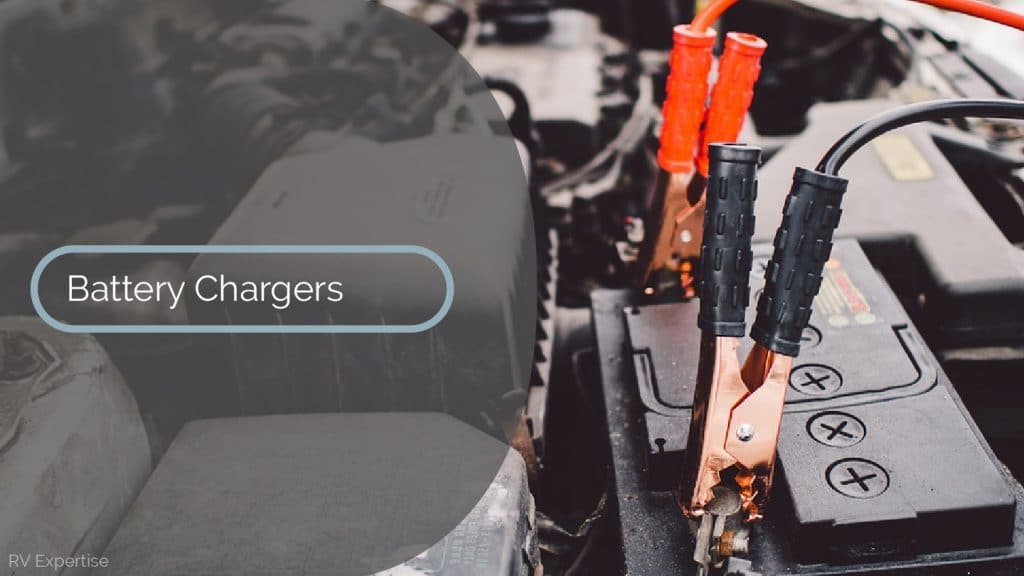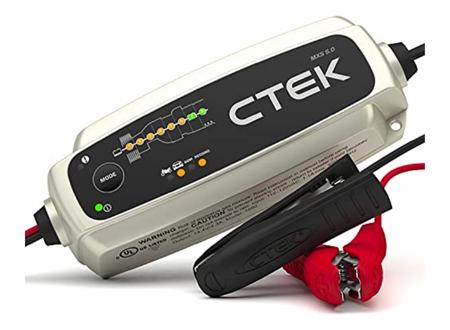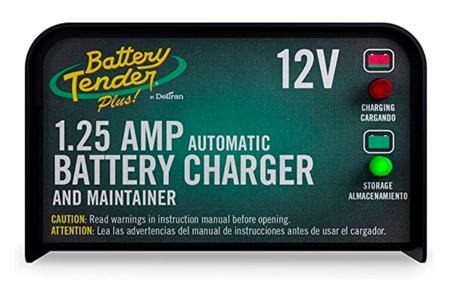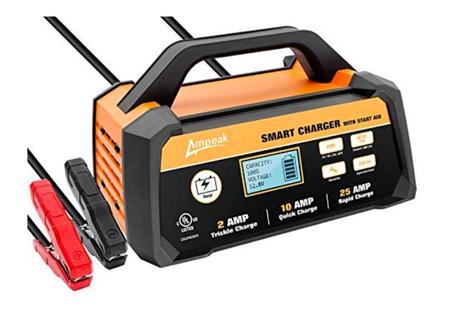The 5 Best RV Battery Chargers (Reviews For 2025)

Almost all RVs come with their own battery charging system. However, the majority of those systems aren’t the best they could be. They could potentially damage the RV battery by overcharging or even undercharging.
There are various charging systems that can greatly improve your RV battery charging system or even provide an emergency backup.
This article will discuss the various features of some of the top RV battery chargers on the market, along with their pros and cons.
RVExpertise.com is reader-supported. When you buy through the links on our site, we may earn an affiliate commission. Visit our disclaimer page for more information.
Best RV Battery Chargers
| CTEK MXS 5.0 Fully Automatic Battery Charger and Maintainer | Schumacher Electric Battery Charger and Maintainer | Battery Tender Plus Battery Charger | |
|---|---|---|---|
 |  |  |
|
| Voltage: | 12 Volts | 6V or 12V | 12 Volts |
| Current: | 4.3 amps | 1.5 amps | 1.25 amps |
| Weight: | 1.3 Pounds | 1.3 Pounds | 1.45 Pounds |
Quick Answer: The 5 Best Rated RV Battery Chargers For 2025
- CTEK MXS 5.0 Fully Automatic Battery Charger and Maintainer
- Schumacher Electric Battery Charger and Maintainer
- Battery Tender Plus Battery Charger
- Ampeak Car Battery Charger,2A/10A/25A Battery Charger
- CTEK D250SE, 20A, 12V Battery Charger
Best RV Battery Charger Reviews
1. CTEK MXS 5.0 Fully Automatic Battery Charger and Maintainer
- Voltage: 12 Volts
- Current: 4.3 amps
- Weight: 1.3 pounds
The overall best charger on the market is the 12V CTEK. The patented eight-step process will maximize the performance of your battery, as well as prolong the overall lifespan. The process includes a desulfation step that removes any sulfate from lead plates. The reconditioning step also helps extremely discharged batteries.
Moving on, the LED display will allow you to monitor the full charging process, which helps limit the chances of overcharging. You’ll also have peace of mind, as this charger has plenty of safety features to protect you and ensure the overall effectiveness of the device. These include no sparks, no short-circuiting, reverse polarity protection, as well as protection against water and dust.
Bottom Line
The patented maintenance process is one of the greatest benefits this charger offers. The unique process can maintain and enhance effectiveness and battery life. The safety features are also a large part of why this is the best charger on the market.
The safety features are what offer the customer such great peace of mind. The only downside with this battery charger is that it might take some research to be able to set it up. However, this is expected with all technical products. Another downside is that because of it being a 12V battery charger, it might take a while to charge.
2. Schumacher Electric Battery Charger and Maintainer
- Voltage: 6V or 12V
- Current: 1.5 amps
- Weight: 1.3 pounds
This charger provides your 6V or 12V battery with a 1.5-amp maintenance. You’ll be happy to know that the controlled microprocessor has multi-stage charging, which means far longer battery life with no safety concerns, whatsoever. The auto-voltage detection will be able to detect any 6V or 12V batteries.
A great safety feature you’ll enjoy is the reverse hook-up protection, which ensures the charger won’t work if the clamps are used in reverse. With your purchase, you’ll receive a few things, including the battery clamp and ring connector harness which offer you a quick connection.
Bottom Line
There is a good reason as to why this product was voted the best value for money. It has all the features of a normal charger, such as the multi-staged charging, which enhances the overall performance of the battery and lifespan.
The safety features are also great and save you from making deadly mistakes. A good benefit is that you’ll have everything you need to start charging right away. The only real downside is that the multi-stage charging is only four stages long and isn’t as effective as other models.
3. Battery Tender Plus Battery Charger
- Voltage: 12 Volts
- Current: 1.25 amps
- Weight: 1.45 Pounds
This product was close to the top spot with some great features. The automatic charging and maintenance are what attract a lot of people. The charger is designed to fully charge a battery and maintain the storage voltage with no damaging effects as a result. The charger boasts that the 1.25-amp charger is just as fast as any other 3-amp charger.
You’ll have plenty of safety features to protect your battery, including polarity protection, short-circuit prevention, and overcharging protection. With your purchase, you’ll also receive a quick-connect harness for hard to reach areas, multiple battery tender ring terminals, and alligator clips. The terminals will automatically switch from full charge to a floating charge.
Bottom Line
This product is great at what it does. It effectively regulates itself without any problems and will charge just as fast as the three-amp models. You’ll greatly benefit from the safety features that are also mentioned.
The only downside with this product is that it doesn’t have the best lifespan. If you take a look at the Amazon reviews, they’re not the best. The manufacturer also isn’t helpful at all when you’re looking for a refund or a replacement.
4. Ampeak Car Battery Charger,2A/10A/25A Battery Charger
- Voltage: 12 Volts
- Current: 2A,10A, 25A
- Weight: 3.74 pounds
What Recent Buyers Report
Most people who purchased this product were satisfied with it, with buyers stating that its huge intuitive display told them precisely what was going on. They were particularly impressed with its recondition mode and said that the wiring loom mounts made it incredibly easy to store. However, some users reported that the unit seemed fragile, while some complained that it only worked with batteries that still had some charge.
Why it Stands Out to Us
This product stands out to us for several different reasons. Firstly, its Smart Detect System automatically detects voltage and capacity and identifies the correct charging rate suitable for the battery. Secondly, it boasts a battery-reconditioning feature that helps extend battery life. Lastly, it features a six-step charging system that optimizes battery power without overcharging or damaging it.
Bottom Line
Although this unit has a bit of a learning curve, it’s still an incredibly reliable charger that boasts exceptional features and outstanding performance. Along with being able to quickly charge and maintain a battery, this Ampeak is also UL certified, making it extremely safe to use.
5. CTEK D250SE, 20A, 12V Battery Charger
- Voltage: 12 Volts
- Current: 20 amps
- Weight: 1.54 pounds
Camping with your RV can become a huge nuance without a perfect RV battery charger. You need an efficient charger if you want to keep the appliances inside your RV running smoothly for longer durations. And this is where this exemplary RV battery charger comes in handy. It comes with all the features that make it stand out. Here are some of them.
The model is equipped with 2 charging options that allow it to select the current and voltage according to the situation. This is important because traveling on an RV can be quite unpredictable, and you need a charger that can better adapt to the ongoing changing situation.
Similarly, it has a full automation system that comes with a 5 step charger that can shift the charging voltage. This feature is further complimented by the model’s ability to charge from a plethora of different sources. These include solar panels or alternators. This also means that regardless of the weather or the environment, you will not have your RV charger lacking behind anytime.
Moreover, the model is also considered worthwhile because of the temperature range it accommodates. This range starts from -20 and ends at +50, which means it can cater to a range of appliances easily. Furthermore, the compact size of the model also makes it one of the best and most reliable models in the market.
Bottom Line
For a model to stand out, it needs to have both durability and efficiency, and rest assured that this model has it all. It’s equipped with more diversity and a compact design, which makes operations quite easy. Moreover, it allows for multi charging options, which adds to its worth and, ultimately, its appeal.
How to Choose a Battery Charger
Like all good products, there are plenty of features that make a unit unique or stand out from the competition. The following section will highlight and discuss the features you should be looking out for when searching for your next battery charger.
Vibration Absorption
You need to ensure that it can effectively absorb any vibrations that it creates or has some sort of cradle feature that keeps it off the ground. There are two reasons you should look for this; the first reason being that vibrations can damage your charger battery. Secondly, they can cause some serious noise that really gets on your nerves.
Battery Capacity
Battery capacity is measured by how many amps of power it can offer per hour. The higher the capacity, the better your power situation will be.
However, a higher the capacity usually means that the battery will be larger, so you’ll need to make sure you have the best size for your RV. The best thing to do is to understand how much energy you consume each day and then try to find a battery that can offer the closest to that without sacrificing too much space.
Voltage Power
The voltage is the potential electrical difference. You’ll find that deep cycle and starter batteries will have a 12V DC. This can also be achieved easily by using two 6V DC batteries and joining them together. These aren’t the most powerful, as you can get natural systems like a solar panel that provides 24V batteries, so make sure to look around for the best option.
Types of RV Battery Chargers
There are a few main types of RV battery chargers. The following section will discuss the features of the most commonly used types.
Converter Charger
This is a basic charging system. It can convert 120V shore power into 12V DC power. This means the battery won’t be needed to provide DC when plugged in. It’ll also charge the battery only when it has space, eliminating overcharging damage. The device can produce 55 amps of direct current and has the ability to power a variety of appliances. These batteries can either be single-stage or multi-stage
Inverter Charger
Most modern RVs will use an inverter charger. This has all the same features as the standard converter charger, however, it has the ability to produce 120V of alternating current from the 12V battery, when there’s no shore power available.
Solar-Powered Charger
Solar-powered RV chargers are a great way to access a constant stream of energy. Different sizes offer varying levels of power. This also depends on the weather conditions. A large, 150-watt solar panel can fully power your RV for a day, as long as you have a panel that offers 14V or more. However, solar panels take a lot of planning and maintenance.
Top Brands in the RV Battery Charger Space
If you’re looking for the best RV charger or battery maintainer brands, here are some of the best ones out there.
NOCO
The NOCO is an excellent all-around brand for your RV battery charger. Noco has been around since 1914 and at the top of the game in innovation and manufacturing premium, durable battery chargers. Not only is the brand compatible with a wide range of batteries, but it is also ideal for deep cycle batteries. This amazing charger can discover battery sulfation and acid stratification automatically to help restore any lost battery performance. It starts a dead battery quickly and also maintains your RV battery.
Stanley
Stanley is a household name, and rightfully so. It has a history of designing efficient tools and it’s been around since 1843. The brand’s RV charger delivers fast and easy results. It provides smart charging, keeps the battery at an ideal charging rate, automatically changes charging modes as needed, and lets you track the charging process and battery maintenance, making your battery last longer.
Powermax Converters
Powermax Converters is a Florida-based company that started in 2005. It has designed quality converters, RV battery chargers, and other products for multiple power supply needs. It works as both an effective battery charger and a power converter. It is travel-ready, thanks to its compact size and built-in three-stage charging.
Price Points of RV Battery Charger
Having a handy RV battery charger makes it easy to power your battery. They come in various styles, capacities, and sizes.
RV Battery Charger Pricing
Under $50
The RV battery chargers in this category do the basics. They charge your RV’s battery. A limited amount of extras come with battery chargers in this range. You’ll typically get a very affordable deep cycle battery charger with a warranty period, a built-in dual-color LED indicator and a very low charging speed.
$50 to $100
This price range includes battery chargers with useful upgrades that also help you maintain your RV battery. They may provide additional perks toward the high end of the range. These chargers are versatile and you might be able to charge a car battery marine battery. This smart deep cycle battery charger has a comparatively slower charging speed and is safe to use outdoors in all seasons.
$100 and up
These battery charging products offer both high power and impressive additional features. This range includes premium options. You will find that they prevent overcharging and undercharging and can be used for multiple batteries at once. They typically have more than one battery bank, are suitable to jump-start cold batteries, and have many safety features with a high maximum amperage rating.
Comparison Overview
There are several different types of battery chargers, and each has its own unique set of features. To ensure you understand their similarities and differences, and choose a unit that best suits your needs, the following is a comparison between different types of battery chargers:
Deep Cycle Battery Charger vs Regular
A regular battery charger and deep cycle battery charger can be a bit difficult to differentiate. Here’s how they compare:
Similarities
The main similarity between regular and deep cycle battery chargers is their purpose:
Operation
Both regular and deep cycle batteries can charge lead-acid batteries and basically operate with the same chemistry.
Differences
There are several differences between the two type of chargers, including:
Charging Speed
Regular battery chargers usually charge at 10 to 15 amps in fast charging mode, and two amps in slow charge mode. On the other hand, deep cycle battery chargers don’t charge faster than two amps, which is good for the battery.
Cooling Off Period
After recharging a battery to its full capacity with a deep cycle battery charger, you’ll need to let it cool off before connecting it to the RV to avoid burnout. However, if you use a regular battery charger, you can immediately put the battery to use.
Battery Maintainer vs Trickle Charger
Both trickle chargers and battery maintainers can keep a battery charged, but are suitable for different purposes. Some of their similarities and differences include:
Similarities
Battery maintainers and trickle chargers have one major similarity:
Purpose
Battery chargers and trickle chargers have a similar look. Both are plugged into a wall and work by converting the AC power into usable power for the battery. They’re also hooked to the battery in a similar way using jumper cable like cords.
Differences
The two types differ in several ways, such as:
Charging Speed
Trickle chargers have a slower charging speed than battery maintainers. This means that they take a longer time to fully charge a battery.
Smart Technology
Battery maintainers are programmed to determine the amount of power in the battery to avoid overcharging, whereas trickle chargers continually apply small charges to the battery. This means that they’ll keep charging the battery, even if it is fully charged.
Manual Battery Charger vs Automatic
Automatic and manual battery chargers are the two most common types of chargers used to maintain and charge lead-acid batteries. Let’s see how they compare:
Similarities
Both types are similar because they essentially have the same purpose:
Use
Both manual and automatic chargers are capable of fully charging a battery, depending on the charger’s output and the size of the battery.
Differences
Manual and automatic batteries have several differences, including:
Monitoring of Battery
Since automatic chargers are designed to charge and maintain batteries, you can connect them to the battery for as long as you want without worrying about overcharging. However, you’re going to have to carefully monitor the battery when using a manual charger to avoid overcharging or seriously damaging the battery.
Price
Manual chargers are usually less costly than automatic ones. They also don’t analyze the battery and will continue charging it until they’re disconnected from the battery.
Cautious Considerations When Buying a New RV Battery Charger
When using new electronics or technical products, there are certain risks attached and you should always be aware of those risks in order to avoid them. The following section will discuss a few cautions we’d like to offer before messing around with your battery charger. The main risks aren’t with the battery charger, but with messing around with the actual battery itself.
Explosive Gas
One of the dangers of lead-acid batteries is the hazardous hydrogen gas it creates. You should ensure adequate ventilation when charging using this method, as a simple spark could cause an explosion.
Life-Threatening Acid
Another hazard is the sulfuric acid that’s included inside the battery. If that is spilled on someone, it would burn through their clothes and could mean life-threatening injuries. Make sure to have the necessary safety casings and features to stop these accidents from happening.
How to Use a Battery Charger
Safely charging a dead battery takes more than just connecting a charger. It’s essential that you follow the instructions listed in the manual of your specific charger, but the basic steps on how to use a battery charger are as follows:
- Disconnect the battery cables from their respective terminals. Remove the negative or black cable first, and then remove the positive (red) cable.
- Switch off the charger and make sure that it’s not connected to an electric outlet.
- Connect the positive charger cable to the positive terminal and the negative charger cable to the negative terminal.
- Determine the speed at which you want to charge the battery. A lower charging current and voltage is suitable for a trickle charge, whereas a higher setting will be needed for a quicker charge. Although a trickle charge provides the best results, make sure you read the manual to understand the settings.
- Decide whether the charger will automatically power down once the battery is completely charged or will operate for a certain amount of time.
- Leave the charger in one place and don’t move it when the battery is being charged.
- Switch off and disconnect the charger once the battery is completely charged.
- Disconnect the cables, removing the negative cable first, and then the positive cable.
To get a better understanding of how to use a battery charger, make sure you watch the following video:
Conclusion
Charging your battery can be a dangerous process and it can also be a long process. However, if you follow our advice and all the research, you’ll be fine. We hope this article has helped educate you on what features to be looking out for when battery charger shopping.
FAQs About RV Battery Chargers
With so many different types and models of battery chargers available, choosing the best one can be an extremely confusing and difficult task. To help ensure you choose a unit that best suits your needs, here are some of the most frequently asked questions:
What Size Battery Charger Do I Need For My RV?
A good rule of thumb is that your battery charger should be at least 10% of the Ah rating of the battery. For instance, a 200Ah battery requires a 20 Amp charger as a minimum. Your charger size should be around 20% of the total capacity to hinder overcharging.
Should I Disconnect My RV Battery When Plugged In?
When storing your camper, turn off your disconnect so that your battery discharges more slowly. When you turn off the disconnect when plugged into the shore power, it removes the connection of batteries from the power charging supply.
Do RV Batteries Charge When Plugged Into Shore Power?
Yep, they do. When you switch on your battery and connect it to the shore power, it charges safely. Using shore power to charge your RV battery is a superb way to make sure your battery is ready and prepared for whatever activities you want to take on.
Can You Use a Trickle Charger on a RV Battery?
Trickle charging is ideal for lead acid battery charging (your RV likely has a lead acid battery) that will be sitting idle for a while. As they sit, they lose their charge slowly. A trickle charge will slowly recharge the starting battery, keep it healthy, strong, and maintaining its life cycle.
How Do I Read a Battery Charger Amp Meter?
Once the charger is switched on, the meter’s needle will move to the desired amps. When the battery starts charging, the needle will gradually move down. Once the needle drops to nearly half the desired amp, then this indicates that the battery is fully charged.
How Does a Battery Charger Work?
Battery chargers generally charge a battery by providing a pulsed DC or constant DC power source to it. Usually, a high-quality charger has a slower charging speed because it’s designed to use a lower and safer charging rate.
Should You Leave Your RV Connected to the Charger All the Time?
Although you can leave your RV connected to the charger all the time, you’ll need to monitor the house batteries. It’s advisable to check the electrolyte levels of the batteries every month so that you know if they’re low or are about to go dry.
Can You Leave a Trickle Charger Connected All Winter?
Trickle chargers are designed to be left connected to car batteries for long periods of time for recharging. Some models can be left on batteries for an indefinite period of time, making them ideal for vehicles that are stored away in the winter.
What is a Power Inverter?
A power inverter is an electronic device that changes direct current into alternating current. The output voltage, input voltage, and power handling differ according to the design of the device. Power inverters allow you to plug in your devices and appliances, and operate them like you would with an electrical outlet in your house.
Can You Overcharge an RV Battery?
Constant overcharging can cause batteries to sulfate more quickly, resulting in reduced effective performance. Thus, it’s better to charge the battery fully and then remove it from the RV during long periods of non-use.
How Do I Know My Battery Charger is Working?
- Plug the charger into an electrical outlet and remove any batteries connected to it.
- Switch on the voltmeter unit, and follow the meter’s instructions on how to connect the test probes.
- Use a battery pack or battery that’s compatible with the charger, and connect it.
- Check the voltmeter’s readout and see which side the pointer is leaning towards. If it’s indicating to the left side, then swap the test probes.
- A negative reading indicates a bad charger that needs to be replaced.
How Much is a Battery Charger?
Shelf-model standard battery chargers usually cost around $30 to $100 and are suitable for charging 12V car batteries. The price depends on the size and weight of the charger. On the other hand, the cost of portable car battery chargers can range from $16 to over $500.
Effectiveness
Quality
Value
The CTEK MXS 5.0 Fully Automatic Battery Charger and Maintainer is our Editors Choice for the best RV battery charger

Hello, fellow wanderers! I’m Alyssia. Since 2008, my husband and I have called an RV our home, journeying through life one mile at a time. Our nomadic lifestyle has led us to over 70 countries, each with their unique tales that have shaped our own.
I share our stories and insights right here, hoping to inspire and guide you in your own adventures. Expect tips on RV living, our favorite camping spots, breathtaking hiking trails, and the joys and challenges of an ever-changing view from our window. Alongside, you’ll also find practical advice on outdoorsy stuff, designed to equip you for any journey. Join us as we continue to explore the vast, beautiful world on wheels!






